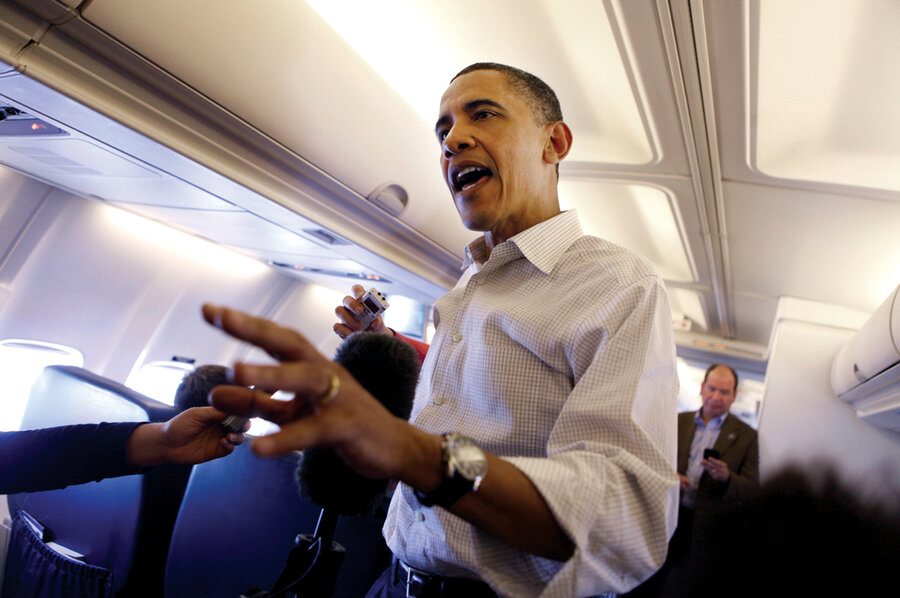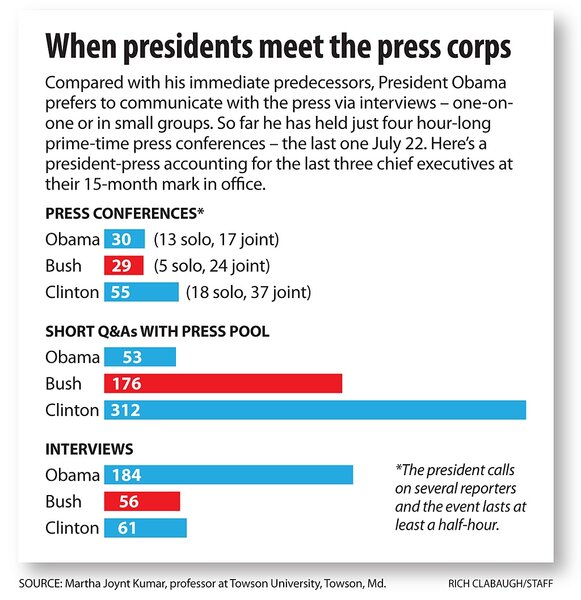Obama and the press: Who said they were cozy?
Loading...
| Washington
By the time President Obama stepped up to the podium last Thursday in the East Room, the news media were fully primed - not only with questions about the BP oil disaster, but with this factoid: It was Mr. Obama's first full press conference since July 22, 2009.
The public may have felt Obama entered office with an adoring press corps, but if that was ever true, it certainly is not now.
Frustrations over access have been widespread. And it's not just the infrequency of hour-long press conferences (six since taking office, including just four during prime-time). Obama has had far fewer short question-and-answer sessions with the press pool than did his two immediate predecessors: only 53 in his first 15 months in office, versus 176 for President Bush and 312 for President Clinton, says Martha Joynt Kumar, a political scientist at Towson University in Towson, Md.
Analysts of White House communications say the buck stops with Obama himself. If he was interested in having more daily give and take with reporters, it would happen. Obama's approach speaks to the type of person he is - as a policy person, an academic, a lawyer -- and his strategic view of the presidency.
"His animus is driven by his persistent focus on the long term," says Michael Cornfield, an expert on politics and the media. "He sees the 24-hour news cycle and the battle for the day's headlines as a distraction, not as something worth pursuing."
So why, then, does he do far more sit-down interviews with reporters than his two immediate predecessors? According to Ms. Kumar, Obama gave 184 interviews (both group and individual) in his first 15 months in office, compared with 56 for Bush and 61 for Clinton during the same period of time, according to Kumar.
"He does interviews because he wants to talk at length and in depth about his policies - like spending almost an hour talking to David Leonhardt of The New York Times about the economy and how health-care, energy, and education are all a part of it," says Kumar. "That takes a while to do. So he avoids short Q-and-A's for that very reason. You're asked to respond to something that's unfolding, where you don't have all the facts and where you're expected to speak briefly, and you can't get into any depth."
Obama makes plenty of public statements, after he and staff have had time to craft the wording carefully. But the more rapid response falls to the communications operation, when it's willing to oblige. Some White House reporters complain that it can take hours to get confirmation of a news item that's already been leaked to and reported by one outlet, such as with Elena Kagan's selection for the Supreme Court.
And it's not that Team Obama is lacking for personnel. This White House has 70 people working communications, versus 57 under Bush, Kumar says. It's more a question of how the team chooses to deploy its resources. In April, members of the White House Correspondents Association (WHCA) met with White House press secretary Robert Gibbs to suggest improvements, including more reporter interaction with the president and more access by news photographers and TV cameras to small presidential events, such as bill-signings and meetings with world leaders.
Since that meeting, "it's been up and down," says Ed Chen, WHCA president and a veteran White House reporter, now with Bloomberg. Photographer access has improved, but reporters are still frustrated by Obama's tight lips. A recent press availability with Obama and Mexican President Felipe Calderon amounted to just two questions.
Reporters who covered candidate Obama say they wouldn't have expected him to act this way as president.
"Obama gave regular access to reporters and took questions regularly during the campaign," says Caren Bohan, a reporter for Thomson Reuters and a WHCA board member. "So I've been surprised at the lack of willingness of the White House to make him available for question-and-answer sessions with reporters, now that he's in the White House."
There have been some bright spots in the Obama White House's communications approach: White House visitor logs are now public. Communications director Dan Pfeiffer regularly blogs -- the first person in his position to do so -- giving the outside world (mainly the media) an important window into administration thinking on issues. Last July, Mr. Gibbs started holding occasional "gaggles," relaxed but on-the-record Q-and-A's with reporters, in his office. These sessions are free of TV cameras, and therefore less dominated by TV reporters.
Aside from blogs, the White House has embraced other new media, such as Twitter. In April, the media shop started posting weekly videos on WhiteHouse.gov (and YouTube) called "West Wing Week" - a brisk, at times irreverent look at the past week's presidential doings. For the most part, these six-to-eight minute video compilations consist of footage of public events, but with enough backstage moments - shot by the official White House videographer -- to suggest the old TV show "West Wing."
To the news media, "West Wing Week" can seem rather Soviet, that is, faux journalism trying to look like the real thing. Ditto the videotaped interview with Ms. Kagan the White House posted the day after her nomination to the Supreme Court. But from the White House's perspective, it's all about experimenting with the array of outreach methods at its disposal - - not trying to go around or over the "filter" of the mainstream media.
"In some ways, it's a case of trying new things," says a senior administration official speaking on background. With public interest in the Obama presidency high, "we're in an incredibly rapid-fire media environment, and I think we've been successful at managing it."
Is the White House communications strategy working?
If the goal is to help the president sell his policies - and performance as chief executive - to the public, then the results are mixed.
Obama's job approval, averaging just below 50 percent, is higher than approval of most of his policies, and much higher than that of Congress. His personal popularity is well into the 50s, a sign that he is wearing well with much of the public even amid economic challenges and two wars. The massive Gulf of Mexico oil spill is the latest big test - both for Obama and for his entire administration. It could end up being the biggest test of all.
Related:
Three reasons Obama on YouTube is better than a press conference



